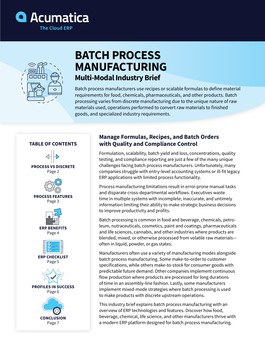
Acumatica's Industry Brief Multimodal Batch Process

Batch process manufacturers use recipes or scalable formulas to define material requirements for food, chemicals, pharmaceuticals, and other products. Batch processing varies from discrete manufacturing due to the unique nature of raw materials used, operations performed to convert raw materials to finished goods, and specialized industry requirements.
Batch process manufacturers have similar financial, order management, and inventory requirements as discrete manufacturers. However, recipe and formula definitions may be drastically different from discrete bills of material. Further, production workflows often vary based on batch production requirements with highly specialized quality and compliance requirements for government and industry regulations. Unlike discrete manufacturers, product variants are common with additional controls required to ensure product quality. Production reporting must be flexible for multiple finished goods from batch orders with robust reporting and analysis tools to ensure safety and compliance.
Manage Formulas, Recipes, and Batch Orders with Quality and Compliance Control
Formulation, scalability, batch yield and loss, concentrations, quality testing, and compliance reporting are just a few of the many unique challenges facing batch process manufacturers. Unfortunately, many companies struggle with entry-level accounting systems or ill-fit legacy ERP applications with limited process functionality.
Process manufacturing limitations result in error-prone manual tasks and disparate cross-departmental workflows. Executives waste time in multiple systems with incomplete, inaccurate, and untimely information limiting their ability to make strategic business decisions to improve productivity and profits.
Batch processing is common in food and beverage, chemicals, petroleum, nutraceuticals, cosmetics, paint and coatings, pharmaceuticals and life sciences, cannabis, and other industries where products are blended, mixed, or otherwise processed from volatile raw materials—often in liquid, powder, or gas states.
Manufacturers often use a variety of manufacturing modes alongside batch process manufacturing. Some make-to-order to customer specifications, while others make-to-stock for consumer goods with predictable future demand. Other companies implement continuous flow production where products are processed for long durations of time in an assembly-line fashion. Lastly, some manufacturers implement mixed-mode strategies where batch processing is used to make products with discrete upstream operations.
Download Multimodal Batch Process PDF